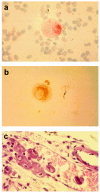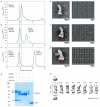Human Cytomegalovirus Cell Tropism and Host Cell Receptors
- PMID: 31336680
- PMCID: PMC6789482
- DOI: 10.3390/vaccines7030070
Human Cytomegalovirus Cell Tropism and Host Cell Receptors
Abstract
In the 1970s-1980s, a striking increase in the number of disseminated human cytomegalovirus (HCMV) infections occurred in immunosuppressed patient populations. Autopsy findings documented the in vivo disseminated infection (besides fibroblasts) of epithelial cells, endothelial cells, and polymorphonuclear leukocytes. As a result, multiple diagnostic assays, such as quantification of HCMV antigenemia (pp65), viremia (infectious virus), and DNAemia (HCMV DNA) in patient blood, were developed. In vitro experiments showed that only low passage or endothelial cell-passaged clinical isolates, and not laboratory-adapted strains, could reproduce both HCMV leuko- and endothelial cell-tropism, which were found through genetic analysis to require the three viral genes UL128, UL130, and UL131 of the HCMV UL128 locus (UL128L). Products of this locus, together with gH/gL, were shown to form the gH/gL/pUL128L pentamer complex (PC) required for infection of epithelial cells/endothelial cells, whereas gH/gL and gO form the gH/gL/gO trimer complex (TC) required for infection of all cell types. In 2016, following previous work, a receptor for the TC that mediates entry into fibroblasts was identified as PDGFRα, while in 2018, a receptor for the PC that mediates entry into endothelial/epithelial cells was identified as neuropilin2 (Nrp2). Furthermore, the olfactory receptor family member OR14I1 was recently identified as a possible additional receptor for the PC in epithelial cells. Thus, current data support two models of viral entry: (i) in fibroblasts, following interaction of PDGFRα with TC, the latter activates gB to fuse the virus envelope with the cell membrane, whereas (ii) in epithelial cells/endothelial cells, interaction of Nrp2 (and OR14I1) with PC promotes endocytosis of virus particles, followed by gB activation by gH/gL/gO (or gH/gL) and final low-pH entry into the cell.
Keywords: HCMV; Nrp2; PDGFRα; cell tropism; cellular receptors; epithelial cells/endothelial cells.
Conflict of interest statement
Conflict of interest: The authors declare no conflicts of interest.
Figures





References
-
- Sinzger C., Grefte A., Plachter B., Gouw A.S.H., The T.H., Jahn G. Fibroblasts, epithelial cells, endothelial cells and smooth muscle cells are major targets of human cytomegalovirus infection in lung and gastrointestinal tissues. J. Gen. Virol. 1995;76:741–750. doi: 10.1099/0022-1317-76-4-741. - DOI - PubMed
-
- Sinzger C., Digel M., Jahn G. Cytomegalovirus cell tropism. Curr. Top. Microbiol. Immunol. 2008;325:63–83. - PubMed
-
- Plachter B., Sinzger C., Jahn G. Cell types involved in replication and distribution of human cytomegalovirus. Adv. Virus Res. 1996;46:195–261. - PubMed
Publication types
Grants and funding
LinkOut - more resources
Full Text Sources
Research Materials
Miscellaneous

